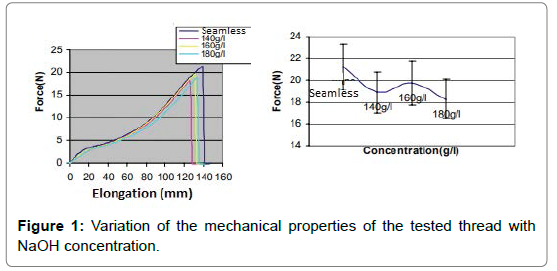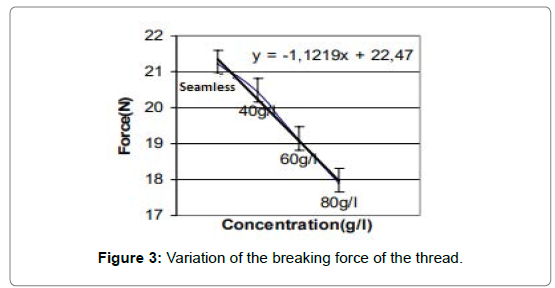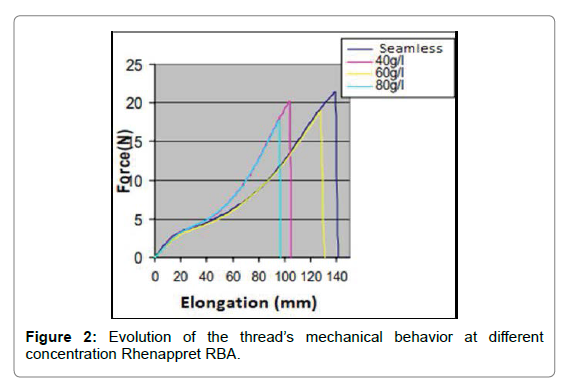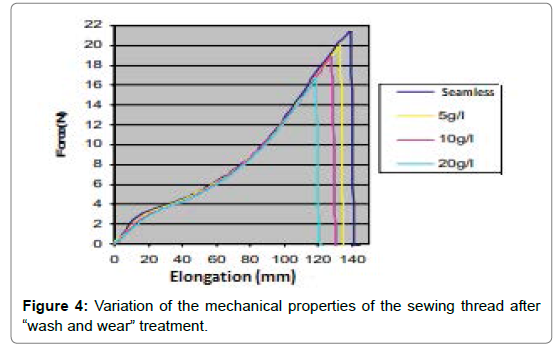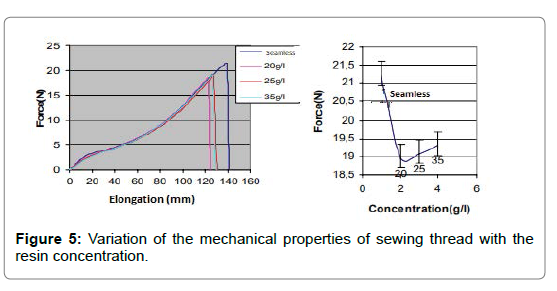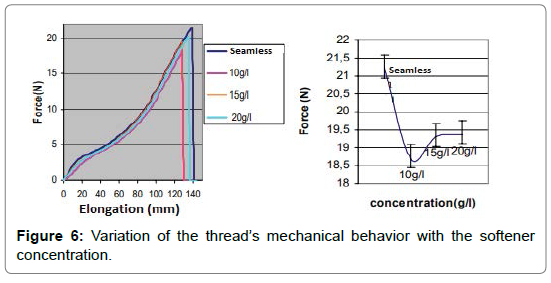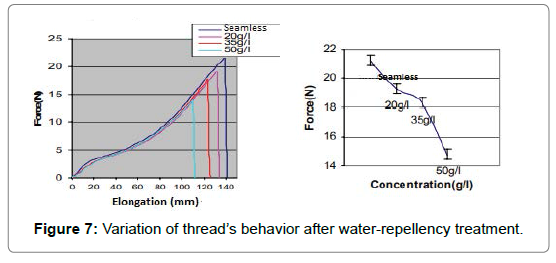Research Article, J Fashion Technol Textile Eng Vol: 9 Issue: 9
Influence of Finishing Products on the Mechanical Properties of Sewing Thread
Mansouri Samar1,3*, Chaabouni Yassin2, Cheikhrouhou Morched2
1Laboratory of Environmental Chemistry and Clean Processes (LCE2P), Monastir Tunisia
2Higher Institute of Arts and Crafts in Sfax, Monastir, Tunisia
3Higher Institute of Arts And Crafts in Kasserine, Monastir, Tunisia
- *Corresponding Author:
- Mansouri Samar
Laboratory of Environmental Chemistry and Clean Processes (LCE2P), Monastir, Tunisia
E-mail: Samar20481@yahoo.fr
Received Date: August 20, 2021; Accepted Date: September 28, 2021; Published Date: October 05, 2021
Citation: Samar M, Yassin C, Morched C (2021) Influence of Finishing Products on the Mechanical Properties of Sewing Thread. J Fashion Technol Textile Eng 9:9. 222.
Copyright: © All articles published in Journal of Fashion Technology & Textile Engineering are the property of SciTechnol, and is protected by copyright laws. “Copyright © 2021, SciTechnol, All Rights Reserved.
Abstract
This research is an opportunity to highlight the influence of finishing products on sewing-thread’s behavior. Various treatments were applied on fabric with different concentrations (mercerizing, softening, Stiffening, Anti-Wrinkling treatment, Water repellent). The finishing processing was released in the finishing factory in the Industrial Company of Textile “SITEX”. The quantity of finishing product depends on that used in the company. After sewing, the needle thread was removed from fabrics then tensile properties (force and elongation at break) are determined. The mechanical parameters were compared to those of the seamless thread (before seaming operation). After sewing, the thread was solicited and was subject to frictions which destroy its mechanical properties. The results show a significant loss in mechanical properties values depending on finishing treatment. In that, decreases related to mercerizing treatment are different from those related to water repellent or softening treatment. Also the variation of force and elongation at break values change when varying products’ concentration used. For most finishing products, raising the quantity added inhibits the penetration of the sewing thread into treated fabric. Softening treatments, normally, ease thread’s moving in the textile fabric, but increasing softener’s concentration, can make it very difficult to pass into fabric tested. So, finishing product’s concentration is an important parameter that must be investigated.
Keywords: Finishing products; Sewing thread; Tensile properties
Introduction
In the textile field, finishing process is occurred either to confer more pleasing appearance and handle to the fabric or to give it new properties for a particular end use. There are different ways to finish a textile fabric. In that, simple physical or mechanical treatments can change the appearance and properties of textile fabrics significantly. These are called dry treatments in which little or no water is used. On the other hand, chemical finishes are known as wet treatments. All of them have an important role in textile manufacturing. They are responsible for functionalizing textile fabrics which can create new conceptual textile systems for the 21st century [1]. So, finishing stages affect fibers, yarns and fabric’s behavior [2,3]. Also, they have an important influence on needle penetration force and seams mechanical behavior [4,5].
Sewing process is used to transform bi-dimensional structure on three-dimensional one. It involves different elements. It is an assembly of woven fabric by sewing threads using the appropriate machine. So, all of these elements have an important effect on seamed product, which can be investigated. It is very important and complex, in that, it requires great efforts in order to achieve good quality to satisfy consumers’ needs. Its importance can be recently justified by the large number of research studies. Indeed, several studies aim to investigate seaming operation and its environment [5-13]. Sewing thread as an important component of a sewn garment contributes significantly to the quality of clothes [14]. An important consideration is given to thread’s behavior during sewing steps [15,16].
To the best of our knowledge, none of the past studies on sewing thread properties have considered the effects of finishing products. This study is devoted to highlight the modification occurred on the mechanical and physical behavior of needle thread. In that, the lockstitch is formed by the interlacement of needle and bobbin threads. During seaming process, needle thread is subjected to repeated tensile stresses, heat, bending, pressure and torsion. Therefore, its mechanical properties change with variation of woven fabrics properties. The initial part of this paper focuses on the evaluation of mechanical properties of sewing thread, when changing the concentration of each finishing product.
Material and Methods
We have adopted the following strategy: We carry out the assembly of two fabric inserts with a speed of 1000 trs/min and a point density equal to 5 points/cm. The sewn length is such that the length of the line makes it possible to carry out the tensile tests later. Then we destroy the bobbin thread to recover the needle one without exerting stress. After that, thread’s properties were determined.
Remark: The choice of the needle thread and not the bobbin one is justified by its frequent contact with fabric during seaming operation.
Carrying out the tests: To determine the breaking strength and elongation of studied yarn we used the standard NFG 07-003. The distance between clamps is 500 mm, the thread’s rupture must be after 20s ± 3s. The pre-load to be applied to the sample before tightening clamps is equal to 0.5 cN ± 0.1cN per tex of linear density of the yarn.
Characteristics of fabrics and sewing threads used: To achieve the main objectives of the present investigation, DENIM fabric released in SITEX (Industrial Company of Textile) was used. The fabric is composed of 95% Cotton and 5% Elastane (C95E5). Its characteristics are presented in the following (Table 1).
| Fabric code | Weave | Density(thread cm-1) | Thickness.(mm) | Weight(g m-2) | |
|---|---|---|---|---|---|
| Warp | Weft | ||||
| C95E5 | twill 4 | 26 | 17 | 0.72 | 294 |
Table 1: Fabric’s characteristics.
Grey fabric was mercerized and then impregnated in a bath containing resins for stiffening, anti-wrinkling treatment and softening. Next, it was softened by fabric softener. These various treatments were carried out with three different concentrations of finishing products. Mercerizing and softening were applied in the Industrial Company of Textile “SITEX”. Stiffening, anti-wrinkling treatment and softening using resin were done in the finishing factory in the same company. In addition, water-repellent treatment was carried out on non-treated fabric using an adhesive resin. To ensure the reaction of resin’s polymerization, all last resin treatments were done at 170°C for 1-2 min. Then samples were cooled at room temperature. Finally, the different tests were released. Each indicated value presents the average of 5 tests and the difference among values is less than 5% (Table 2). Seaming operation was released using a needle thread presenting the following characteristics mentioned in the (Table 3).
| Treatments | Products | Concentrations(g. L-1 ) | ||
|---|---|---|---|---|
| C1 | C2 | C3 | ||
| Mercerizing | Sodium hydroxide | 140 | 160 | 180 |
| Stiffening | *Rhenappret RBA (Thor SARL France) | 40 | 60 | 80 |
| Anti-Wrinkling treatment | *Quecodur LT(Thor SARL France) | 5 | 10 | 20 |
| Softening by resin | *Finistrol (Thor SARL France) | 20 | 25 | 35 |
| Softening by polishing substance | *Appreture 166(Cognis) | 10 | 15 | 20 |
| Water repellent | Adhesive resin | 20 | 35 | 50 |
Table 2: Different concentrations of used products.
| Thread code | Fibres used | Linear density (tex) | Twisting (twist/m) | Tenacity (cN/tex) | Elongation (%) |
|---|---|---|---|---|---|
| S45 | PES | 45 | 438 | 47.13 | 27.13 |
Table 3: Characteristics of sewing thread used.
Results and Discussion
In this part, we present the modifications of thread’s properties in terms of resistance and elongation at breaking point, after assembly. This was done for the same fabric when varying concentrations of each product.
Influence of mercerization: The fabric made from cotton wrinkles easily and is difficult to dye. It is, therefore, treated with sodium hydroxide to make it strong, lustrous and absorbent [17]. This treatment affects fabric’s properties such as the resistance to needle penetration during seaming process [4]. First of all, we present the sudden variations noted in the thread’s mechanical behavior. The (Figure 1) shows that the shape of the force/elongation curve remains unchanged. The change appears at the breaking point. Indeed, we notice a decrease in elongation. This resulting decrease is detected in the thread used to seam mercerized fabric with a NaOH (soda) concentration of 140 g/l, is 8% compared to a seamless yarn. By increasing the concentration of soda to 160 g/l and 180 g/l, we notice a low recovery at the level of elongation about 2.2%. As regards the variation of the breaking force, it follows the elongation’s evolution. Indeed, the thread used to sew the mercerized fabric with 140 g/l of soda, loses 10.94% of its initial strength. At a concentration of 160 g/l, the strength improves by 4.5% compared to that of the assembly yarn used for fabric treated in a bath containing a concentration of soda equal to 140 g/l. The thread, frayed from the fabric treated in a bath containing a high quantity of soda, loses 13.7% of its initial strength. These results are justified by the fact that the swelling of cotton fibers, caused by soda even at low concentrations, causes the reduction of elongation and breaking force. In fact, significant friction with the fabric weakens the mechanical characteristics of the sewing thread. The improvement, even of small percentage, of the mechanical behavior results from the increase of the concentration of soda. Indeed, at high concentrations, the soda destroys the structure of the cotton fiber. So the structure of the warp and weft yarns will be modified. As a result, the interlacing of the sewing thread becomes easier. This keeps the mechanical properties after sewing. The decrease in strength and elongation of the thread used to assemble a mercerized fabric with 180 g/l of sodium hydroxide is linked to the narrowing of the mono filaments of elastane. Indeed, the higher the concentration of soda, the greater the shrinkage. This leads to the destruction of the mechanical properties of the sewing thread.
Influence of stiffening: The purpose of the stiffening treatment is to improve the self-maintenance of the fabric to facilitate its handling during assembly operation. As a result, the load added to the fabric generates changes in thread’s behavior inside the fabric. This generally affects the characteristics of the sewing thread. In our study, we used a flexible self-restretchable polyacrylic thermoplastic resin (Rhenapprêt). (Figure 2) shows the evolution of the mechanical behavior (force/elongation) of the sewing thread according to different concentrations of the resin acquiring stiffness to the treated fabric. We note that the shape of the force/elongation curves of the different concentrations is the same in the elastic zone. Therefore, with low tensile stresses, the concentration of the resin has no influence on the mechanical behavior of the sewing thread. At rupture’s zone, we observe variations in strength as well as elongation of the assembling yarn. We notice a loss of the mechanical properties of the sewing thread. This is proven when comparing the values found for a yarn used in a stiffened fabric assembly by 40 g/l of the resin with the results of the seamless yarn. The highest reduction in elongation is noticed for the concentration of 80 g/l. The percentage decrease is equal to 32%. For a concentration of 60 g/l, the loss in elongation is minimal. The variation in resistance is linear. This is given by (Figure 3). Indeed, the breaking force of the sewing thread is inversely proportional to the concentration. The percentage decrease is of about 6%. This variation is produced by the amount of resin. Indeed, the latter is selfrestretchable, so its polycondensation causes the cross linking of the cellulosic chains of cotton fibers. This reduces the deformability of warp and weft yarns. As a result, the insertion of the sewing thread becomes more difficult due to the rigidity of the fabric threads. Thus, friction increases, which destroys the sewing thread’s structure.
Influence of wrinkle-free treatment: We used a «wash and wear» treatment. We used the most usable resin in the textile field. It is characterized by its smoothing and irreversible efficiency [18].
Figure 4 shows the evolution of the mechanical behavior of yarn took of the treated fabric. We notice a loss in its strength and elongation of break. The percentage of decrease in the strength is 14.3%. In the same way, the breaking elongation change. These results are justified by the very principle of smoothing treatment. Indeed, the product used is a reactive resin that is fixed by a chemical bond thanks to the OH groups of cellulose. As a result, the internal interstices of the cellulosic structure will be filled. Subsequently, the cotton fibers swell. This favors the smoothness of the textile material. But in the other hand, the interlacing of the sewing thread through this fabric causes its destruction.
Influence of softening with resin: This treatment is done by a silicone elastomer that allows easy penetration into the fiber. This product allows a soft touch and an improvement of the fiber’s elasticity. Therefore, the deformability of the yarns increases [19]. So the penetration of the sewing thread into the fabric will be easy. (Figure 5) shows the variation of thread’s behavior with softening resin’s concentration. Thus, we notice an improvement in strength and elongation at high resin concentration. With high resin concentrations, we detected 10% of decrease by comparing the preand post-seam strength of the softened fabric with 20 g/l of resin. This may be due to the assembly operation.
Influence of softening with softener: The influence of the softener concentration on the mechanical properties of the sewing thread is given in (Figure 6). We notice that by increasing the amount of softener in the bath, we will have a conservation of the properties of the sewing thread. This result is justified by the role of the lubricant that the softener plays. Indeed, the decrease in the coefficient of friction between the sewing thread and the warp and weft threads guarantees us the protection of the structure of the sewing thread after interlacing through the fabric [20].
Influence of water repellent treatment: (Figure 7) shows the evolution of sewing thread’s behavior when varying the concentration of the water repellent product after seaming operation. We find that when the concentration increases, we notice a loss in strength that can reach 30% of the initial thread’s strength before sewing. This results from the blocking of the yarns inside the fabric by the resin. Therefore, their rigidity increases. As a result, there is a high friction coefficient, which destroys the thread’s structure and alters its mechanical characteristics [21].
Conclusion
After different tests of extracted sewing thread from treated fabrics, it is clear that according to the properties wanted (softness, stiffness, non-wrinkling...) the finishing products used affect the sewing thread’s behavior differently. So that stiffening, waterproofing and anti-wrinkling treatment which increases the fabric’s resistance to needle penetration because of resins used when making film on the surface; also have an effect on sewing thread’s characteristics. They weaken its mechanical resistance. But, concerning the treatment of softening, the change in thread’s properties is lower; this is due to lubrication produced by products responsible for this treatment either resin or polishing substance. On the other hand, all finishing products must be applied with optimum quantities.
References
- Iheaturu N C, Aharanwa B C, Chike K O, Ezeamaku U L, Nnorom O O, et al. (2019) Advancements in Textile Finishing. IOSR J Polym Text Eng 6: 23-31.
- Sameii N, Mortazavi S M, Rashidi A S, Sheikhzada S (2008) An investigation on the effect of hot mercerization on cotton fabrics made up of open-end yarns. J Appl Sci 8: 4204-4209.
- Shakyawar D B, Behera B K (2009) Influence of softening treatments on hand value of woven fabrics produced from Indian wool and their blends. Indian J Fibre Text Res 34:76-81.
- Mansouri S, Chaabouni Y, Cheikhrouhou M (2014) Influence of Finishing Products on Sewing Needle Penetration Force. Int J Appl Res Text 2: 33-41.
- Kordoghli B, Cheikhrouhou M, Saidene C K (2009) Mechanical behaviour of seams on treated fabrics. Autex Res J 9: 87-93.
- Evangelos L, Ruxu D, Dan S, Jasmina B D, Frank L (1999) An experimental study of needle heating in sewing heavy materials using infrared radiometry. Int. J Cloth Sci Technol 11: 300-314.
- Hersh S P, Grady P L (1969) Needle heating during high-speed sewing. Text Res J 39: 101-120.
- Sundaresan G, Salhotra KR, Hari PK (1998) Strength reduction in sewing threads during high speed sewing in industrial lockstitch machine, part II: effect of thread and fabric properties. Int J Cloth Sci Technol 10: 64-79.
- Kawabata S, Niwa M (1998) Clothing engineering based on objective measurement technology. Int J Cloth Sci Technol 10: 263-272.
- Dorkin C M C, Chamberlain N H (1980) The facts about needle heating. Clothing Institute.
- Nikolic G, Sˇomođi Z, Franulic D (2003) Mechanical properties of sewing stitch performed in frozen state. Int J Cloth Sci Technol 15: 198-203.
- Gribaa S, Amar S B, Dogui A (2006) Influence of sewing parameters upon the tensile behavior of textile assembly. Int J Cloth Sci Technol 18: 235-246.
- Mukhopadhyay A, Midha V K (2013) The quality and performance of sewn seams. In Joining text Woodhead Publ: 175-207.
- Malek S, Khedher F, Adolphe D, Jaouachi B (2021) Sewing Thread Consumption for Chain Stitches of Class 400 Using Geometrical and Multilinear Regression Models. Autex Res J 20: 415-425.
- Mazari A, Akagun E, Havelka A, Mazari F B, Kejzlar P (2016) Effect of sewing speed on the physical properties of firefighter sewing threads. Int Scho Sci Res Inno: 10: 312-315.
- Gurarda A, Meric B (2005) Sewing needle penetration forces and elastane fiber damage during the sewing of cotton/elastane woven fabrics. Text Res J 75: 628-633.
- Jordanov I, Mangovska B, Tavčer P F (2010) Mechanical and structural properties of mercerized cotton yarns, bio-scoured with pectinases. Tekstil 59: 439-446.
- Michallet G (1991) Les apprêts chimiques. Indus Text 1218: 66-73
- Schindler W D, Hauser P J (2004) Chemical finishing of textiles. Elsevier.
- Stylios G, Xu Y M (1995) An investigation of the penetration force profile of the sewing machine needle point. J Text Inst 86:148-163.
- Nair A U, Patwardhan B A, Nachane R P (2013) Studies on friction in cotton textiles: Part II- A study on the relationship between physical properties and frictional characteristics of chemically treated cotton fabrics. Indian J Fibre Text Res 38: 366-374.
 Spanish
Spanish  Chinese
Chinese  Russian
Russian  German
German  French
French  Japanese
Japanese  Portuguese
Portuguese  Hindi
Hindi 